The Thermal Data
Moving on from the restriction test bench the HWLabs Black Ice GTX was loaded into the thermal test chamber for a series of tests – consisting of 3 flow rates, each having 3 different fan rpm rates tested. I felt the thermal test data was most important and which you as the reader would be most interested in.
Below is the final data results gathered from at least 2 data logging runs at each flow rate and fan rpm combination. The most stable 15 minute period from each logging run was used and then averaged with the other runs to obtain the data for the table below. A total of 16 temperature sensors were used in the thermal test chamber (8 air in, 2 air out, 3 water in, 3 water out) each take a reading every second and logged via a CrystalFontz unit. The data in the table below is the averaged results of the logging runs which has then been used to create all the plots and tables there-after.
The performance metric of critical importance is the delta between the warm coolant temperature in and the cold ambient air temperature in to the radiator. Given that the system is well insulated and in equilibrium and we know the heat input to the system then we can also calculate a very important number – that is the amount of power required to raise the coolant temperature 1C (or 10C which is more useful reference point).
Let’s take a look at the Delta T results from the tests, in bar chart form first:
I was not too concerned about the actual delta numbers, more so the trend pattern. Most noticeable here is the lack of variation between the flow rates at each fan speed in Push/Pull.
It seems a good a spot as any to mention that the OptiFlow testing on all the rads that could benefit from it produced some results that were not as expected. The Black ice GTX was no exception and despite numerous retesting the results left us bewildered at times at some of the data which was produced. Some of the discrepancies we can attribute to test error margins – that being uncontrollable fluctuations of the test rig such as power fluctuating which can effect fan speeds, flow rate and heater power. This despite having a 1000watt power conditioner between the wall and the PSU.
What I am saying is that despite our best efforts some of OptiFlow Vs. Reverse Flow comparisons never made sense to us. I wish I had a proper explanation for some of these results, but at this stage unfortunately I do not. So I am going to call it as the data presents and try to ignore the abnormalities that may exist.
Delta T results (as above) are not always helpful when thinking about how many radiators you would need to cool your system. Instead it’s more useful to know the delta/W, or more usefully, the inverse metric of W/delta C. The metric plotted below tells us how many watts are dissipated by the radiator when the coolant rises 10C above ambient temperatures. (W/10 Delta T):
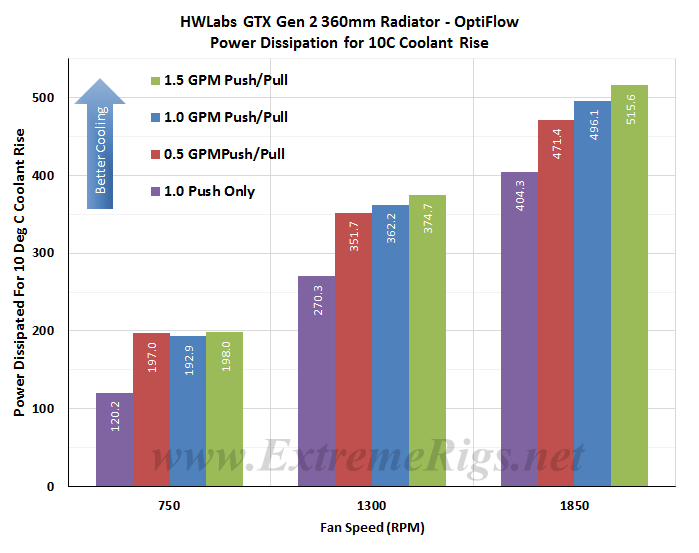 As expected increasing airflow through the radiator is the primary determinant in changing the radiators performance.
As expected increasing airflow through the radiator is the primary determinant in changing the radiators performance.
This data can now be plotted as a pretty curve so that an end user can interpolate their own fan speed. Note again that the extrapolation of the curve is much more sensitive to error than in between the tested range. Let’s exclude the push data for now and come back to it:
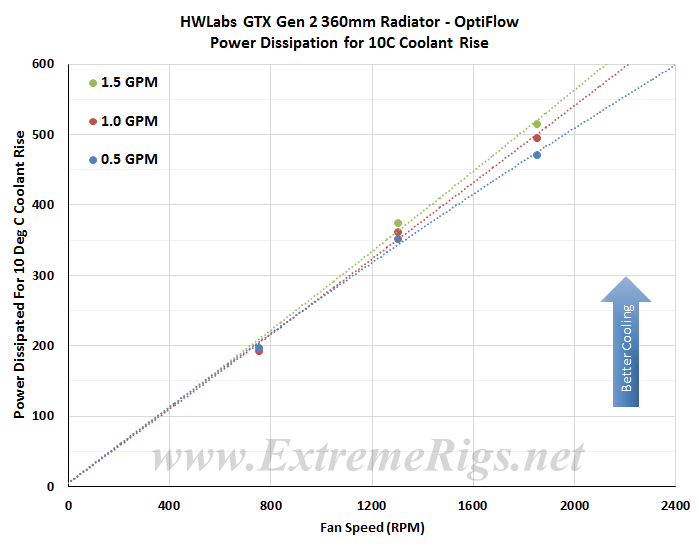 Evidence again that increasing flow rate is yielding very little benefit in performance as the fan speed is increased. These straight lines indicate some very good Push/Pull comparison results coming up for the GTX. Due to the lack of curvature (drop off) at higher fan speeds it also indicates that the GTX’s performance would benefit from even higher fan speeds (if noise was not a concern)
Evidence again that increasing flow rate is yielding very little benefit in performance as the fan speed is increased. These straight lines indicate some very good Push/Pull comparison results coming up for the GTX. Due to the lack of curvature (drop off) at higher fan speeds it also indicates that the GTX’s performance would benefit from even higher fan speeds (if noise was not a concern)
If we now come back to the Push Only data it’s good to compare only the push to push/pull in an “apples to apples” fashion by only looking at the 1GPM data:
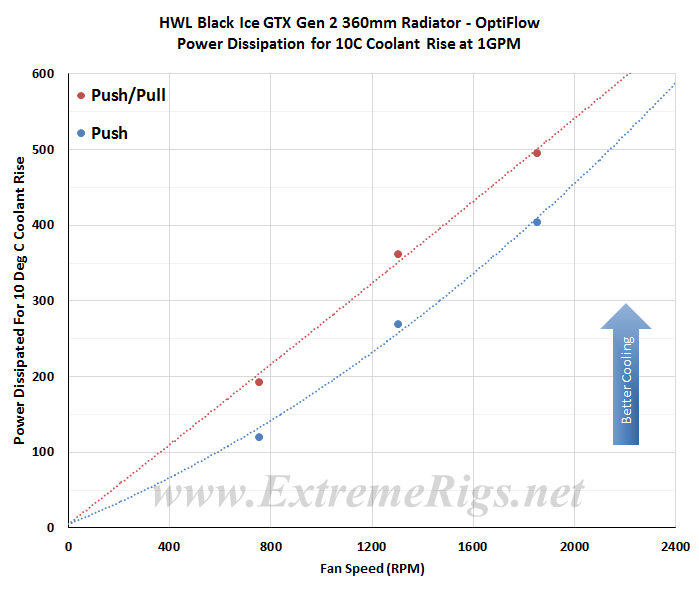 It’s an unusual looking Push Only curve due to the GTX having such poor performance at low fan speeds. Push only gives around 72.5% (averaged) of the performance of the Push/Pull 1.0 gpm test results. This was by far the lowest average of the test group and such big variance shows that Push Only fan assemblies do not offer great performance on the GTX.
It’s an unusual looking Push Only curve due to the GTX having such poor performance at low fan speeds. Push only gives around 72.5% (averaged) of the performance of the Push/Pull 1.0 gpm test results. This was by far the lowest average of the test group and such big variance shows that Push Only fan assemblies do not offer great performance on the GTX.
In this next plot all three Push/Pull results at each flow rate were averaged to produce one curve and we compared the results against one of the best and worst performers from the first test group. Averaging reduces test error of course so this helps further to be sure of our data and is more useful therefore for comparing to other radiators.
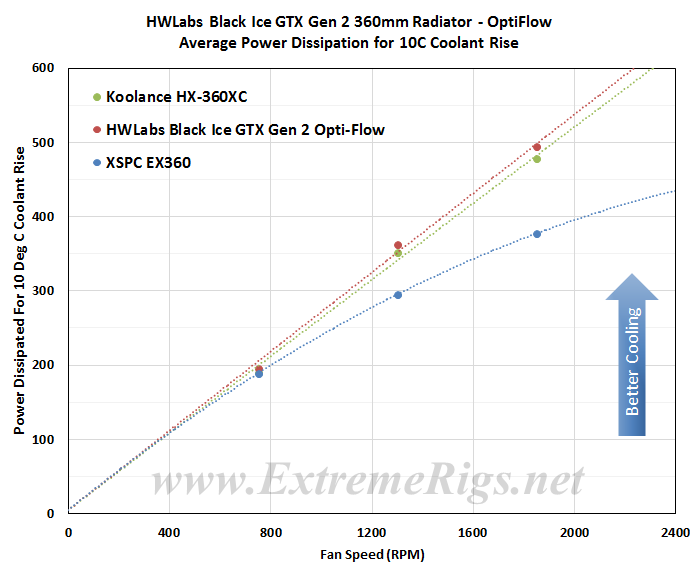 As you can see the GTX is ahead of the Koolance, which has a similar core design and is also targeted for high speed fan performance.
As you can see the GTX is ahead of the Koolance, which has a similar core design and is also targeted for high speed fan performance.
Now let’s analyze that data some more…








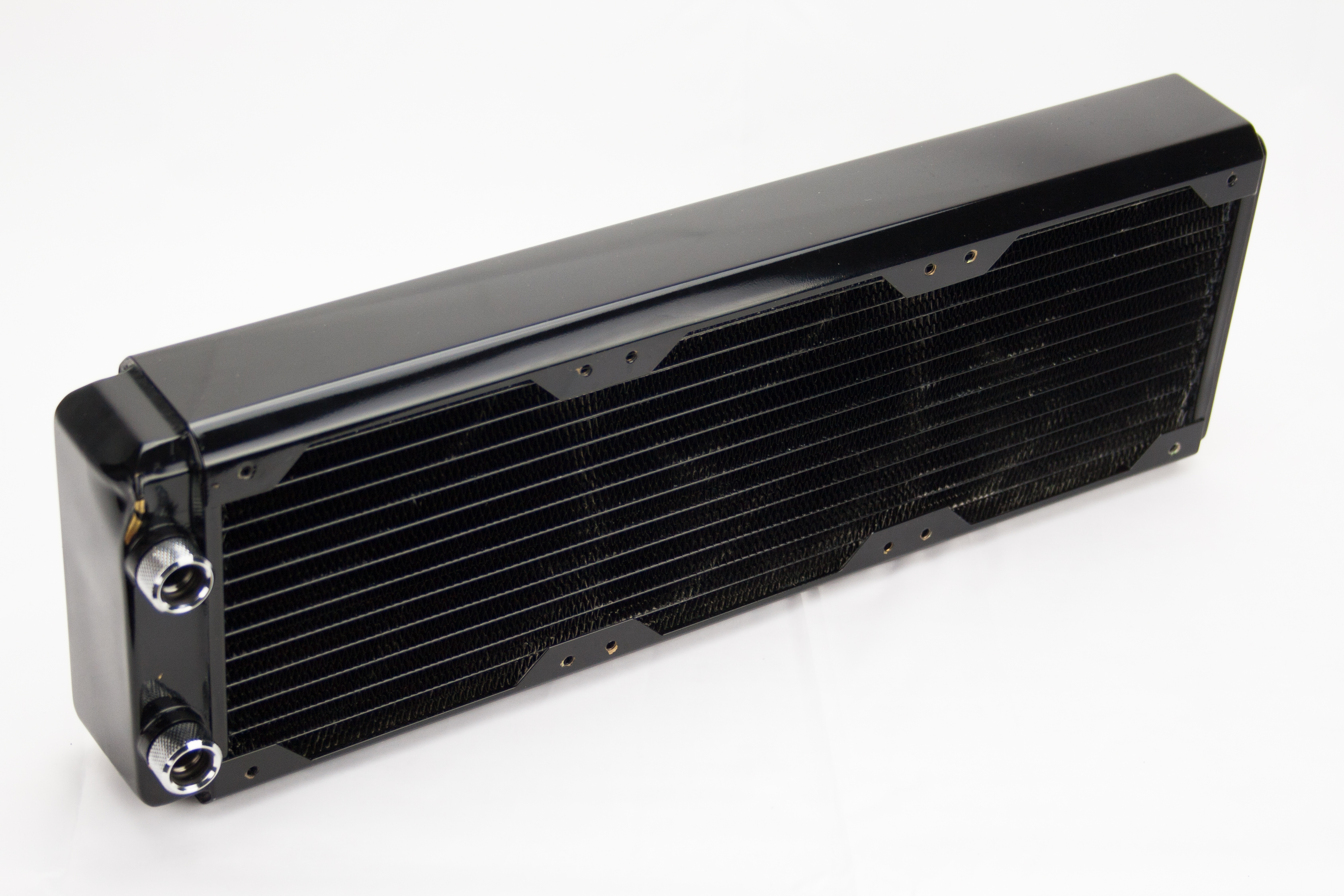
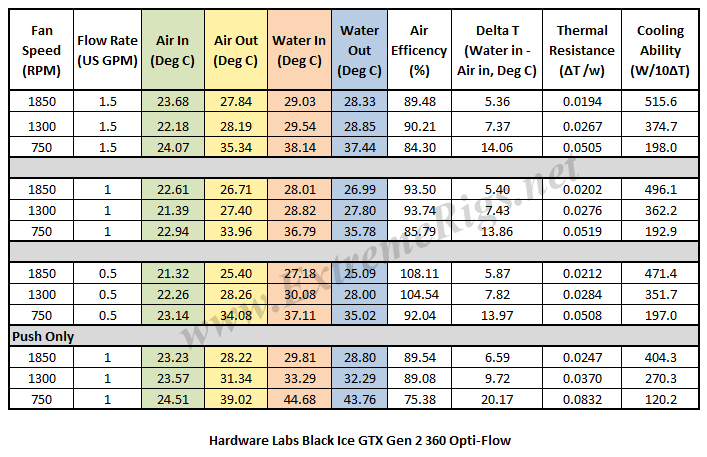
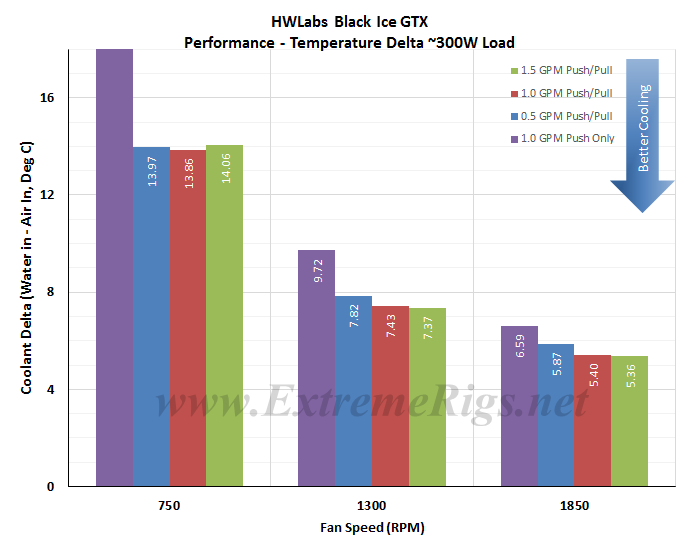



[…] Hardware Labs Black Ice® GTX 360mm Radiator Review […]
Thanks for the review again.
I think that the issue of screw protectors again, seems to be a design flaw. This is a bigger problem with the GTX 360 than other radiators simply because it is a radiator designed for high rpm fans. By nature, you are far more likely to use 38mm fans with such a radiator in push pull for the added static pressure.
Otherwise, it’s a solid radiator.
I would love to see a “Monster” radiator with 20 fpi and a similar design, but I suspect it would be a niche product.
Keep in mind that the GTX is an older model and that what we now consider important features were not always incorporated a few years ago. The current generation of HWLabs offerings all feature protection plates.
If I am not mistaken though the Black Ice GTX Gen 2 though (the variant for high rpm fans in push pull) still does not have screw protectors.
The HW Labs site is currently down so I cannot look it up.
Hi, which fans can use with this radiator?
Any 120mm fans would work – but if you’re buying this rad we would assume it’s to make use of it’s higher performance with highspeed fans. So something in the 2000+RPM is probably the target.
this rad i already have it, can you suggest me 6 fan with low noise?
Thanks in advance
There is a definite intangible when it comes to fan noise. That intangible is the “ear of the beholder.” The quality of sound may not be the same to one listener as to another. This becomes more true when you start moving up to higher speed fans. Another thing to think about, if a fan is tested to emit 29 decibels of sound at 1500 RPM and you need 6 of these fans, each fan adds to the overall noise total. It is not linear, so not 29 dba * 6, it is more of a percentage. Throwing a number out there for sake of example, 6 fans together may emit a constant 38 dba at 1500 RPM. Mounting the fans can cause the noise quality to change. To answer your question with F_F target RPM (not in a specific order): Dark Side Gentle Typhoon 2150 RPM, Noctua NF-F12 Industrial 2000/3000 RPM, Noiseblocker NBe-Loop B12-P / B12-3 & B12-4, EK Vardar F4-120/120ER & FF5-120. A starting place at least.
Comments are closed.